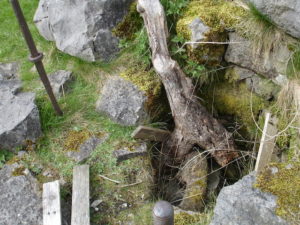With the farmer’s permission, we enjoyed a lovely sunny September walk along the Ings Beck valley from Hollins Farm to Ings End. The total distance was under 1 mile, but there was plenty of industrial archaeology, wild flowers and geological specimens to discover. The purpose was to explore the remains of the Skeleron Mines and for members to discuss and interpret what they could see using the evidence they found.

Pudsey’s 16th Century Bell Pits at Skelleron. Attribution: B. Jeffery
From Pudsey’s ‘Bell-Pits’ (now known as shaft mounds), we looked at the distant views over the Ribble Valley from Longridge Fell to Penyghent and speculated, because of the very adjacent Roman Road, as to whether the Romans mined at Skeleron. There is no evidence to support such an hypothesis, but William Pudsey, Lord Bolland, did try a little coin counterfeiting and was only pardoned by Elizabeth I, because she was his godmother
There is no evidence of mining in the 17-18C’s, but the mines were briefly reopened in the 1850’s for barytes, which was used to smooth paper, paint and cloth. Miners from the Yorkshire Dales, including the Baynes family, migrated into the Rimington area to escape rural poverty. Joseph Baynes, the mine superintendent, died in 1877. It was the Cornish Mine Captain, John Borlase, who from 1877 ran the barytes, lead and zinc mine for Baynes & Colville (later York & Lancaster United Mining Co.) until 1884. The Borlase family, including 7 children, lived above Pudsey’s ‘Bell-Pits’ in an old railway carriage brought from Rimington Station.

A mine shaft at Skelleron.
Attribution: B. Jeffery
In 1884 came disaster. The Company was fined £5 for irresponsible storage of explosives, James Wiseman, the banksman, fell to his death down the 165ft shaft and John Borlase died. The Company was liquidated and James Borlase, John’s son , ex-railway contractor and new mine agent, was declared bankrupt in 1885
The 20C brought a few desultory attempts to reopen the mine, but all were short-lived. Today, the mining area is very overgrown, but sufficient evidence remains for a very pleasant walk. We found lots of interesting specimens of barytes and the lead ore called galena, but most discussion was over the various uses of mysterious overgrown bumps, ditches, adits, shafts and other holes discovered en-route. A lot of time was spent looking for the lead-tolerant Spring Sandwort on Pudsey’s Mounds, but without success, as, presumably, it was the wrong season. However, with Barrie’s expertise, lots of plants were identified.

A mysterious mine adit.
A mysterious mine adit. Attribution: B. Jeffery
Most of the walk was off public paths, so we are very grateful for the farmer’s permission to wander at will. We were in very pleasant company, who were full of questions, and we are very pleased that everybody enjoyed themselves.
Brian Jeffery and Peter del Strother
Banner Image: Examaning a lime quarry at Skelleron. Attribution: B. Jeffery